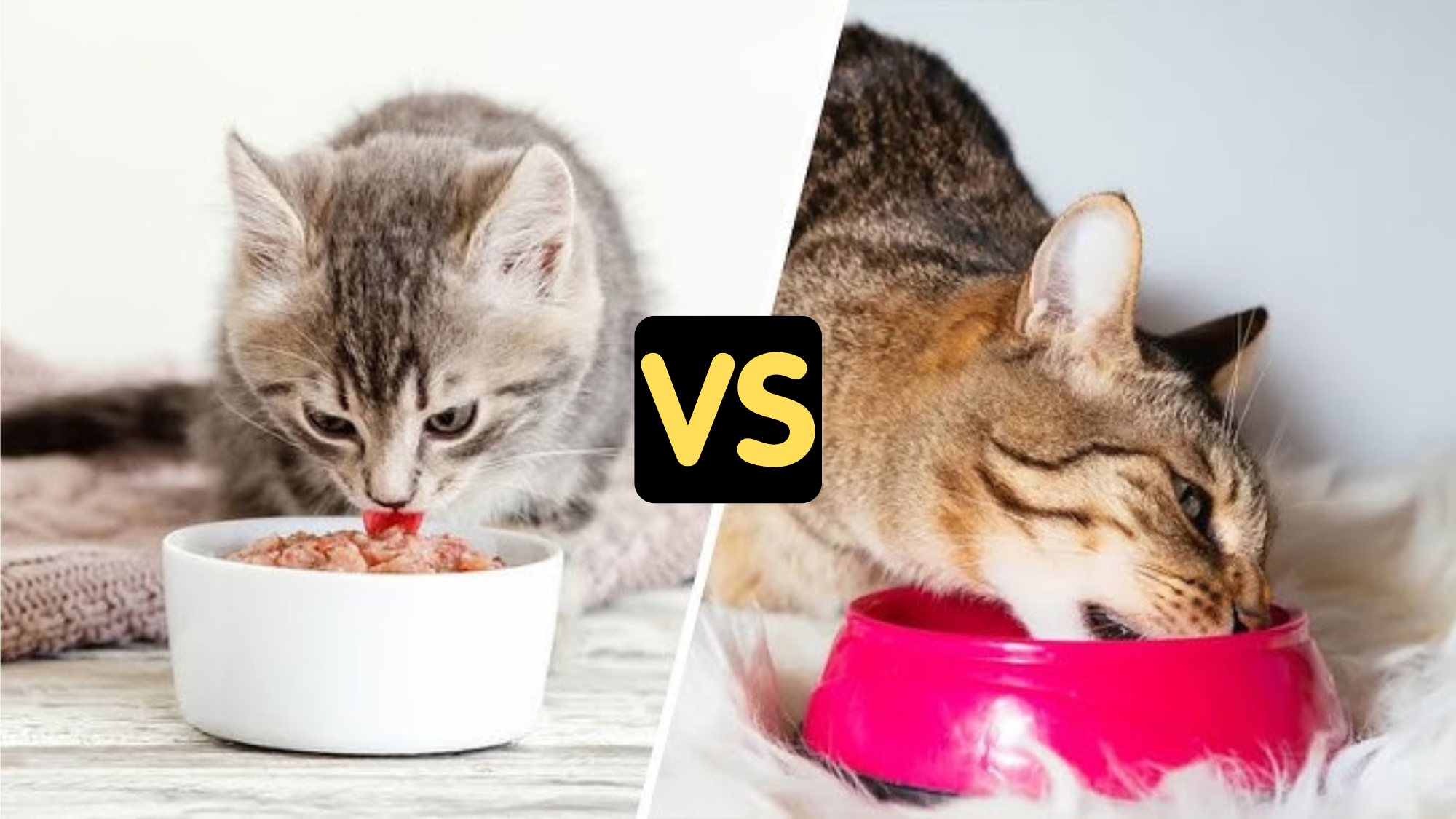| Summary: Kitten food is formulated with higher protein, fat, and essential nutrients like DHA and calcium to support rapid growth and development. Cat food, designed for adult maintenance, has balanced calories and nutrients for sustained health. Feeding kittens adult food may result in deficiencies, while adult cats may gain excess weight on kitten food. |
When it comes to feeding your feline friend, choosing the right food is key to their overall health and happiness. Whether you’re a new cat parent or a seasoned pet owner, understanding the differences between cat food vs kitten food will help you make informed decisions at every stage of your pet’s life. Want to keep track of your dog’s location at all times? Check out the best GPS dog collars to ensure safety and peace of mind.
I’ll break down the main differences in a clear, easy-to-read format. You’ll learn why kitten food is specially formulated for rapid growth and development, and how cat food is balanced to maintain a healthy, mature body. Let’s explore the details—from nutritional composition to feeding schedules, texture, and more.
Ensure your Newfoundland’s comfort and security with expert tips on how to ensure a safe collar fit for Newfoundland.
Blog Highlights
ToggleCat Food vs Kitten Food: Quick Comparison Table
| Factor | Kitten Food | Cat Food |
| Nutritional Composition | Higher protein & fat with extra DHA and taurine for growth | Balanced nutrients for maintenance and overall health |
| Digestibility | Softer texture, easier to chew and digest | Firmer texture to support a mature digestive system |
| Feeding Frequency | 3-4 small meals daily | 1-2 meals daily |
| Caloric Density | Higher calories per serving to fuel rapid development | Lower calories to help prevent weight gain |
1. Understanding Nutritional Composition
Kitten Food: Fuel for Rapid Growth

Kittens experience one of the most critical growth phases of their lives. During these early months, every nutrient counts. Kitten food is specifically designed to be rich in high-quality protein and fats. These ingredients not only support the development of strong muscles but also provide the energy needed for all the playful antics and exploration that characterize kittenhood. From smart feeders to tracking devices, pet tech is changing the game! Explore the latest pet tech products to enhance your dog’s life.
Key components include:
- High Protein Levels: Typically ranging between 30% to 40%. Protein is essential for building lean muscle mass and supporting overall cellular development.
- Elevated Fat Content: Generally around 15% to 25%. Fat provides a concentrated source of energy and is crucial for brain development.
- Enriched with DHA: Docosahexaenoic acid is an omega-3 fatty acid vital for the development of the brain and retina.
- Extra Taurine: An essential amino acid that plays a significant role in vision, heart function, and overall growth.
- Vitamins and Minerals: Increased levels of calcium and phosphorus ensure healthy bone and dental development, while vitamins support the immune system.
Because kittens are in a rapid state of growth, their nutrient-dense diets ensure that every bite is packed with the necessary ingredients to build a strong foundation for a healthy future. Looking for an effective training tool? Learn about the pros and cons of electronic dog collars and how to use them responsibly.
Cat Food: Balanced Nutrition for Maintenance

Once cats reach adulthood, their rapid growth phase slows down, and their nutritional needs shift. Adult cat food is formulated to provide balanced nutrition that helps maintain muscle mass, support organ function, and sustain energy levels without promoting excessive weight gain.
Features of adult cat food include:
- Moderate Protein Content: Usually between 25% and 35%, sufficient for muscle maintenance without the extra load needed for growth.
- Controlled Fat Levels: Around 10% to 18%, which provides necessary energy while preventing obesity.
- Added Nutrients for Longevity: Formulations often include antioxidants and joint-support supplements that help protect cells from oxidative stress and support long-term health.
- Urinary Health Considerations: Some cat foods are specially formulated to support urinary tract health, an important factor in mature cats.
In essence, while kitten food is about fueling growth, cat food is about sustaining a well-established, balanced body. Training your dog requires the right gear! Here’s a comprehensive list of must-have dog training equipment to help with obedience and behavior.
2. Digestibility and Texture
Tailored for Tender Tummies
Digestibility is a crucial factor in any pet food, and it plays a particularly important role when it comes to kittens. Their digestive systems are still maturing, so the texture and formulation of their food need to be gentle yet effective.
Kitten Food Characteristics:
- Softer Texture: Many kitten foods come in the form of wet food or finely ground dry kibble, making it easier for young cats to chew.
- Enhanced Digestive Aids: Ingredients like digestive enzymes and prebiotics are often added to promote a healthy gut microbiome and enhance nutrient absorption.
- Moisture Content: Higher moisture levels in wet food help with hydration, which is essential for kittens who are still learning to regulate their fluid intake.
Mature Cats and Their Digestive Needs

For adult cats, the digestive system is more robust and can handle a variety of textures. However, the formulation still focuses on maintaining smooth digestion and overall gut health.
Cat Food Characteristics:
- Firmer Kibble: Adult cat food often features a slightly firmer texture, which can help in cleaning teeth and maintaining oral health.
- Fiber-Rich Ingredients: The inclusion of fibrous vegetables or whole grains supports regular bowel movements and a balanced digestive process.
- Variety of Formats: Many adult cats enjoy a mix of wet and dry foods, which not only provides nutritional balance but also adds variety to their diet.
In both cases, ensuring that the food is easily digestible helps maximize nutrient absorption, which is key to your cat’s overall health.
Discover the ideal fit by learning what size collar for Newfoundland dog to ensure your pet’s comfort and safety.
3. Feeding Frequency and Portion Sizes
Feeding Your Kitten: Small Portions, Many Meals

Kittens have tiny stomachs and a voracious appetite driven by high energy needs. To ensure they receive adequate nutrition throughout the day, kitten food is best served in several small meals.
Why More Meals?
- Small Stomachs: Their limited stomach capacity means they cannot handle large meals at once.
- High Metabolism: Rapid growth and active play require constant energy replenishment.
- Stable Blood Sugar Levels: Frequent feedings help prevent hypoglycemia, a common issue in young kittens.
Typical Feeding Schedule for Kittens:
- 8-12 Weeks: Start with 3-4 meals per day, each containing about 1/4 cup of food.
- 3-6 Months: Gradually increase the portion size to around 1/2 cup per meal, maintaining 3-4 feedings.
- 6-12 Months: As they mature, you may begin to transition to 3 meals a day, monitoring their growth and energy levels closely.
Feeding Your Adult Cat: Fewer, Well-Balanced Meals

As cats reach adulthood, their nutritional needs change. Adult cats usually do well with fewer meals, as their metabolism slows and their stomachs grow larger.
Feeding Guidelines for Adult Cats:
- Meal Frequency: Typically, 1-2 meals per day are sufficient to maintain a balanced energy level.
- Portion Sizes: Adult cats generally require larger portions per meal compared to kittens. For example, small breeds might need 1/4 to 1/2 cup per meal, while larger breeds could require 1/2 to 1 cup.
- Consistent Schedule: Feeding at the same times each day helps regulate their metabolism and prevents overeating.
The shift from multiple small meals to fewer, larger meals reflects the change in energy requirements as your cat matures.
4. Caloric Density: Energy Needs at Every Stage
High-Energy Demands of Kitten Food
Kittens are naturally energetic, spending most of their day exploring and playing. This high level of activity requires a dense source of calories to support rapid development.
Caloric Considerations for Kittens:
- Higher Caloric Density: Kitten food typically provides around 450-550 kilocalories per cup to meet the high energy demands.
- Nutrient-Dense Formula: Each bite is packed with the nutrients necessary to fuel growth, from high-quality proteins to essential fatty acids.
- Energy for Play: The higher calorie count supports both physical activity and mental stimulation, ensuring kittens have the energy to explore and learn.
Managing Calories in Adult Cat Food
In contrast, adult cats tend to be less active, and their caloric needs are lower. Overfeeding can lead to weight gain and associated health problems.
Caloric Considerations for Adult Cats:
- Lower Caloric Density: Typically around 350-450 kilocalories per cup, which helps in managing energy intake.
- Balanced Energy Supply: The food is formulated to provide just enough energy to maintain a healthy weight without contributing to obesity.
- Weight Management: Lower caloric intake, combined with appropriate portion sizes, helps prevent common issues like diabetes and joint stress.
By tailoring the caloric density to the energy demands of each life stage, pet food manufacturers ensure that kittens and adult cats get the right amount of fuel for their activities.
5. Transitioning from Kitten Food to Cat Food
When and How to Make the Switch
The transition from kitten food to cat food is a significant milestone. As kittens grow, their nutritional needs evolve, and a gradual dietary shift is essential to avoid digestive upset.
Timing the Transition:
- Ideal Age: Most veterinarians recommend beginning the transition around 10-12 months of age, although this can vary based on breed and individual growth patterns.
- Gradual Change: A slow transition over 7-10 days is key to ensuring your cat’s digestive system adapts without any hiccups.
A Sample Transition Schedule:
- Days 1-2: Mix 75% kitten food with 25% cat food.
- Days 3-4: Adjust to 50% kitten food and 50% cat food.
- Days 5-6: Transition to 25% kitten food and 75% cat food.
- Day 7 Onward: Fully switch to 100% cat food.
Tips for a Smooth Transition
- Monitor Your Cat: Watch for signs of gastrointestinal distress, such as diarrhea or vomiting. If these occur, slow down the transition process.
- Maintain Hydration: Ensure that fresh water is always available during the transition period.
- Consult Your Veterinarian: Personalized advice based on your pet’s health can make the process smoother.
A thoughtful transition helps prevent any adverse reactions, ensuring that your cat continues to thrive as its dietary needs change.
For expert tips on how to fit a collar on a Belgian Shepherd, this guide offers simple steps to ensure your dog’s collar fits securely and comfortably.
6. Cost Considerations: Balancing Quality and Budget
Investing in Your Kitten’s Future
Kitten food often comes at a premium due to the specialized ingredients needed for rapid growth. While the cost may be higher, the benefits are substantial.
Cost Factors for Kitten Food:
- Premium Ingredients: The inclusion of high-quality proteins, fats, and essential nutrients drives up the cost.
- Health Investment: Providing the right nutrition early on can prevent health issues later, potentially saving money on veterinary bills.
- Short-Term vs. Long-Term: Although kitten food is more expensive per serving, it is an investment in your kitten’s overall development and future well-being.
Economical Choices for Adult Cats
Adult cat food is generally more affordable, particularly when purchased in larger quantities. Still, quality should not be compromised.
Cost-Saving Tips for Cat Food:
- Bulk Purchases: Buying in larger quantities can reduce the cost per serving.
- Balanced Formulas: Look for brands that offer high-quality nutrition at a reasonable price.
- Monitor Your Cat’s Health: A well-balanced diet can reduce the risk of expensive health issues down the line.
Balancing cost and quality is key to ensuring that your pet receives the best possible nutrition without breaking the bank.
7. Practical Feeding Guidelines and Daily Tips
Establishing a Feeding Routine
Creating a consistent feeding schedule can simplify your daily routine and contribute to your cat’s overall health.
For Kittens:
- 8-12 Weeks: Begin with small portions (about 1/4 cup per meal) given 3-4 times daily.
- 3-6 Months: Gradually increase the portion size as the kitten grows; continue with multiple daily meals.
- 6-12 Months: Start transitioning to three meals per day while monitoring their growth and activity levels.
For Adult Cats:
- Meal Frequency: Most adult cats do well with one or two meals per day.
- Portion Control: Adjust portion sizes according to your cat’s size, activity level, and weight. Small breeds may require 1/4 to 1/2 cup per meal, while larger cats might need 1/2 to 1 cup.
- Routine Consistency: Feeding your cat at the same times every day can help regulate their metabolism and digestion.
Additional Daily Tips
- Hydration is Key: Always ensure your cat has access to clean, fresh water. This is particularly important when feeding dry food.
- Mixing Textures: Offering a combination of wet and dry food can add variety to your cat’s diet and help support dental health.
- Keep a Feeding Log: Tracking your cat’s food intake and behavior can help you identify any issues early on.
- Regular Vet Visits: These check-ups ensure that your pet’s diet is meeting their nutritional needs and allow for adjustments based on their health.
Creating a balanced feeding routine tailored to your pet’s needs can make a significant difference in their overall health and happiness.
8. The Long-Term Impact of Proper Nutrition
Benefits for Growing Kittens
Proper nutrition during the kitten phase sets the stage for a lifetime of good health. The right food supports not only physical growth but also cognitive development and a strong immune system.
Key Benefits Include:
- Stronger Muscles and Bones: High-quality protein and calcium build a robust framework for future development.
- Enhanced Brain Development: Nutrients like DHA and taurine support neural growth, which is essential during these formative months.
- A Resilient Immune System: A diet rich in vitamins and antioxidants helps kittens fight off infections and illnesses.
Sustaining Health in Adult Cats
For adult cats, nutrition plays a vital role in maintaining overall health and preventing chronic diseases. The right diet can contribute to longevity and a better quality of life.
Long-Term Health Benefits:
- Weight Management: Balanced caloric intake helps prevent obesity, reducing the risk of diabetes, heart disease, and joint issues.
- Muscle Maintenance: Adequate protein supports muscle tone and overall strength.
- Organ Health: Nutrients tailored for mature cats support the function of vital organs such as the liver, kidneys, and heart.
- Dental and Urinary Health: Many adult cat foods are formulated with ingredients that help maintain dental hygiene and urinary tract health.
By investing in a balanced diet that evolves with your cat’s life stages, you’re not only supporting their immediate needs but also contributing to their long-term well-being.
For detailed guidance on selecting the correct collar size for a Belgian Shepherd, this article provides essential tips to ensure your dog’s comfort and safety.
9. Tailor Nutrition to Every Life Stage
Feeding your feline companion the right food at the right time is one of the most important aspects of pet ownership. The differences between cat food vs kitten food are clear:
- Kitten Food: Packed with extra protein, fat, DHA, and taurine to support rapid growth, brain development, and a robust immune system.
- Cat Food: Formulated to maintain a stable, healthy body, support muscle maintenance, and manage energy intake for a more sedentary lifestyle.
Remember, the transition from kitten food to cat food should be gradual and carefully monitored. Always consult your veterinarian when making significant changes to your pet’s diet.
Taking a proactive approach to nutrition now can pay off in the long run. With the right feeding strategies, you can help your cat enjoy a longer, healthier, and more active life—whether they’re bounding around as a playful kitten or lounging gracefully as an adult.
Discover the perfect collar size for an Anatolian Shepherd Dog to ensure comfort and security for your furry friend.
Wrapping Up
The journey from kittenhood to adulthood is full of exciting changes and challenges, and proper nutrition is a cornerstone of this process. By understanding the key differences of cat food vs kitten food in nutritional needs, digestibility, feeding frequency, and caloric density, you’re well-equipped to make the best choices for your pet.
- For Kittens: Focus on nutrient-dense food that supports growth, brain development, and a strong immune system.
- For Adult Cats: Choose balanced nutrition that maintains overall health, prevents weight gain, and supports long-term vitality.
In every stage of your cat’s life, remember that quality matters. Investing in the right food means not only meeting their immediate dietary needs but also setting them up for a lifetime of health and happiness.
Learn more about the unique double-layered coat of an Anatolian Shepherd and how to care for it effectively.
As you continue on your journey of pet ownership, keep these tips in mind and adjust your cat’s diet as needed based on their changing needs and activity levels. With a little attention and care, you can ensure that your beloved feline friend remains energetic, playful, and in optimal health for years to come.





